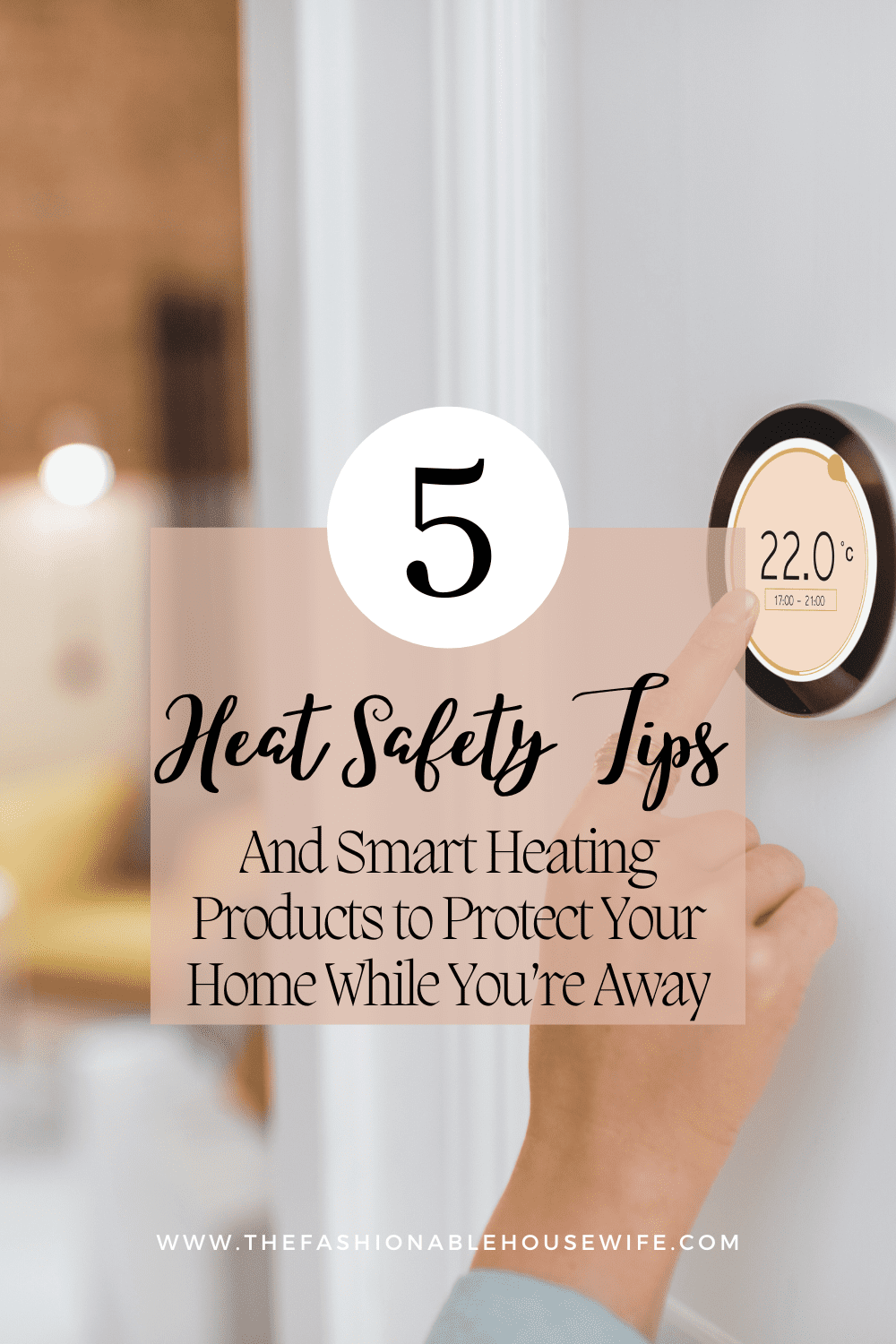5 Heat Safety Tips and Smart Heating Products to Protect Your Home While You’re Away

When temperatures soar, your home’s heating and cooling balance can make or break its safety. Even when you’re away, unchecked heat can strain systems, damage materials, and create hidden hazards. Here’s how smart heating products, heat management and simple precautions can keep your home stable, efficient, and protected.
Heat Safety When You’re Away
Heat safety isn’t just about comfort, it’s about preventing slow-building damage and hidden hazards when no one’s around. Heat doesn’t just raise temperatures; it accelerates everything: wood warps, drywall cracks, plants dry out, food spoils, lithium batteries degrade, and overheated wiring or overloaded appliances can trigger electrical fires. When you’re away, there’s no human “thermostat” to catch the faint electrical smell, the flicker of an outlet, or the sluggish hum of an overworked fan. Maintaining a safe temperature also protects your HVAC system, sudden heat surges strain compressors and shorten lifespan. In short, a stable indoor climate safeguards your property, energy system, and wallet. Heat safety isn’t about staying cool; it’s about slowing time inside your home and protecting materials, wiring, and systems from accelerated wear, that’s real heat protection in action. Regular heating maintenance, and timely heating replacement when older systems start showing strain, are key parts of that long-term heat protection.
Tips For Heat Safety
The biggest tips for heat safety usually fall into a few connected patterns. Appliances like routers, modems, and dehumidifiers generate heat even in standby mode, and when airflow is blocked or filters are dusty, temperatures can climb quickly. Cooling systems aren’t immune either, malfunctioning thermostats or constant cycling can overwork compressors, leading to breakdowns. Meanwhile, high attic or room temperatures dry out insulation, weaken wiring safety, and can even spark ignition if flammable materials are stored in unventilated spaces. Add in food spoilage, wilting plants, and floors expanding from trapped heat, and it’s clear that temperature control matters even when no one’s home. If your system struggles to keep temps stable in extreme weather, planning a furnace installation before peak season can boost safety and reliability.
But it’s not always fire, sometimes it’s creep. Thermal creep is the slow expansion and contraction that loosens electrical connections and cracks caulk or drywall. Heat also throws moisture balance off, drying out wood, leather, and adhesives until they become brittle. And when a thermostat sticks or a fan motor overheats, your HVAC can end up in an endless loop, turning a minor glitch into a power or safety hazard. It’s death by a thousand degrees: subtle, cumulative, and invisible until you return. These tips for heat safety help you prevent that kind of gradual, hidden damage.
Smart Heating Thermostat for Home Safety
A smart heating thermostat is your home’s 24/7 temperature manager. It doesn’t just hold a setting, it learns your patterns, tracks weather changes, and makes micro-adjustments to prevent wasted energy. When paired with sensors in key areas like attics, sunrooms, or basements, it can detect overheating zones and automatically trigger cooling, fan circulation, or phone alerts. The result is a steady, efficient balance, no wasted AC, no heat buildup, and no surprises when you return. Many models also sync with energy-saving modes that reduce consumption during peak hours, cutting heating bills while keeping your home safe.
Most people think of smart heating systems as reactive, “if it’s hot, turn on cooling.” The best ones are predictive. They recognize how your home actually behaves: how long it takes to cool after sunset, how quickly heat builds after noon, even how your walls store warmth. Using that data, they anticipate temperature curves, cooling earlier, coasting longer, and avoiding the all-or-nothing energy spikes. With room sensors, they build a thermal map of your home, transforming simple temperature control into full climate intelligence and true heat protection.
Smart Heating Devices That Prevent Risks
Some next-gen smart heating devices go beyond temperature control, combining monitoring with early hazard detection. The Ecobee Smart Thermostat Premium integrates with smoke and CO detectors, alerting you to unusual heat increases even before smoke appears. Nest Protect works similarly, more than a smoke alarm, it tracks rapid temperature changes that can signal electrical or appliance issues. Compact options like Aqara Temperature & Humidity Sensors send instant alerts when a room exceeds your preset heat threshold, helping you catch hotspots early, while Govee and Eve smart sensors make excellent secondary monitors for attics or garages, pushing notifications straight to your phone.
The real advantage comes from system integration: connecting these devices through a home hub such as Google Home or Apple HomeKit creates layered, room-by-room heat protection. It’s not just about alarms, it’s about systems that notice before the alarm goes off.
Advanced tools like thermographic sensors (for example, the Flir One Edge Pro paired with a smart hub) detect abnormal heat signatures from outlets or wiring long before they reach ignition points. Smart plugs with built-in thermal cutoffs, such as the TP-Link Kasa KP125M, automatically shut down when temperatures exceed safe limits. Meanwhile, AI-powered monitors like Airthings View Plus watch for sudden CO₂ or VOC spikes, early signs of overheating electronics.
True fire prevention isn’t about noise, it’s about silence interrupted by data. That’s smart heating safety done right.
Pre-Trip Heat Safety Checklist
Before heading out, treat your home like a pre-flight check for its climate systems. Set your smart heating thermostat to “away” mode, usually between 82 and 85°F, to save energy while keeping rooms from overheating. Close blinds and curtains on south- and west-facing windows to block direct sunlight. Unplug nonessential electronics; anything with a transformer can generate heat. Clean air filters to maintain airflow, check attic ventilation to prevent trapped heat, and run a quick HVAC test to make sure it cycles correctly before you go.
Then go beyond the basics, think in systems, not checklists. Create airflow memory by propping interior doors open so air can move freely between rooms; stagnant air traps heat. Stabilize humidity by running a dehumidifier for a few hours before leaving, since dry air transfers heat more slowly. Audit phantom loads with a smart power strip to spot heat-producing “always on” devices like printers or cable boxes. And before locking up, take a quick snapshot of your thermostat, humidity, and power data, it’ll tell you instantly if something went wrong while you were away.
These tips for heat safety might seem small, but they break the chain of escalation that turns routine heat into real damage.
Smart Heating and Remote Control Peace of Mind
Smart heating systems connect your thermostat, sensors, and safety devices into a single command center. With automation rules like “if the temperature rises above 90°F, send an alert and turn on the fan,” your home becomes a self-correcting environment. Beyond cooling, automation can trigger power-saving routines, simulate occupancy with smart lights, or pause energy-hungry devices during peak hours. Instead of just monitoring your home remotely, you’re letting it manage itself, and if something goes wrong, you get an alert instantly rather than a surprise when you return.
Automation isn’t just convenience, it’s your home’s nervous system. When you’re away, the house loses its natural feedback loop, no one to notice a draft, shifting sunlight, or a temperature imbalance. Automation fills that sensory gap, responding the way you would. Lights dim as rooms heat up, blinds close during peak sunlight, and fans kick on when humidity rises. It’s not you controlling your house, it’s your house adapting to stay stable with built-in heat protection.
Balancing Comfort and Heat Protection
The trick to real efficiency is layered control, using your smart heating system’s full potential instead of relying on “set-and-forget” automation. Create zones with different temperature targets based on each room’s exposure and purpose. Set thresholds so your system alerts you to sudden temperature or humidity spikes. Schedule cooling cycles around sunrise and sunset rather than running constantly, and link your sensors to your security system, a high-temp alert combined with motion inactivity can reveal a malfunction. Finally, review your system’s data history to fine-tune the balance between comfort and cost. It’s not about adding more tech, it’s about calibrating it strategically.
Think of your home like a body: temperature is comfort, energy is metabolism, and safety is the immune system. To keep that balance, use adaptive rules instead of rigid schedules, for example, “cool when indoor temperature is 10°F higher than outdoor” rather than “cool at 2 p.m.” Set tiered thresholds so you get early warnings before automated interventions kick in, like turning off outlets or sending mobile alerts. And sync lighting with temperature, because true comfort depends on both circadian rhythm and thermal balance. Smart heating thermostat technology shines when systems communicate, not when each runs its own “smart” routine.
Smart Heating Tips for a Safe Return
When you return, start with a quick heat safety check to make sure your home handled the heat safely. Inspect your thermostat’s activity log for unusual temperature swings or alerts. Check air filters and vents for dust or blockages, and note any musty or “hot dust” smells that could point to overheating components. Test outlets and surge protectors to confirm nothing tripped, and review your smart sensor history to see if any rooms reached concerning heat levels. When turning things back on, power up gradually instead of running multiple large appliances at once, it helps avoid sudden electrical strain. These simple tips for heat safety confirm your systems worked as intended and help catch small maintenance issues before they become costly repairs.
But don’t stop at a surface check, think of it as a post-trip autopsy. Review your smart system logs for unusual peaks or extended cooling cycles. Touch-test walls and ceilings in heat-prone areas like attics, closets, and utility rooms; lingering warmth may signal poor insulation or ventilation. Stay alert for ozone or burnt-dust smells that suggest electrical wear. Finally, compare your energy usage during the trip to previous weeks, an unexpected spike is often a clue.
This isn’t just about ensuring safety, it’s about learning how your smart heating setup behaved while you were away, so you can fine-tune it for next time and strengthen your overall heat protection plan.

